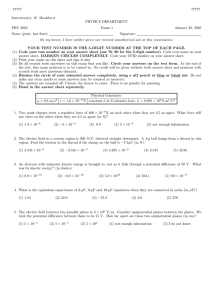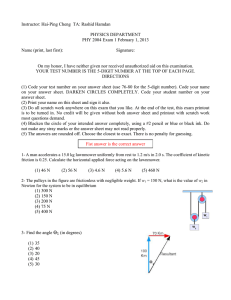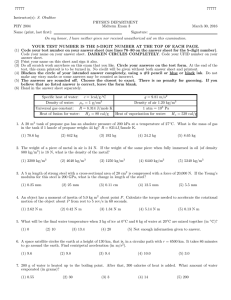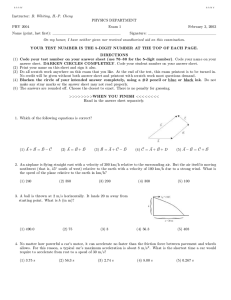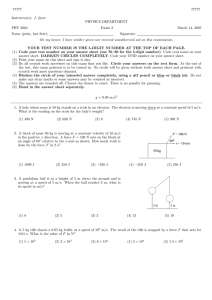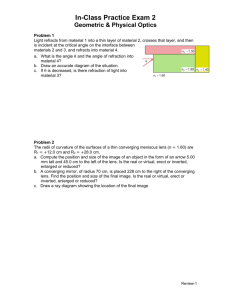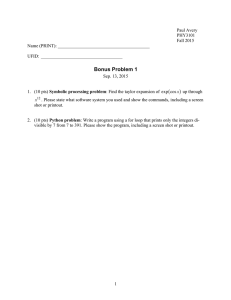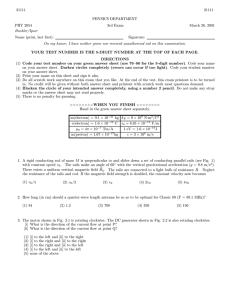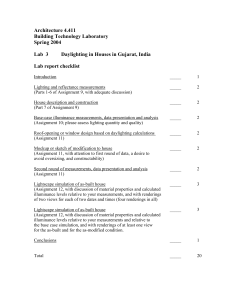77777 H. Monkhorst PHYSICS DEPARTMENT PHY 2005
advertisement
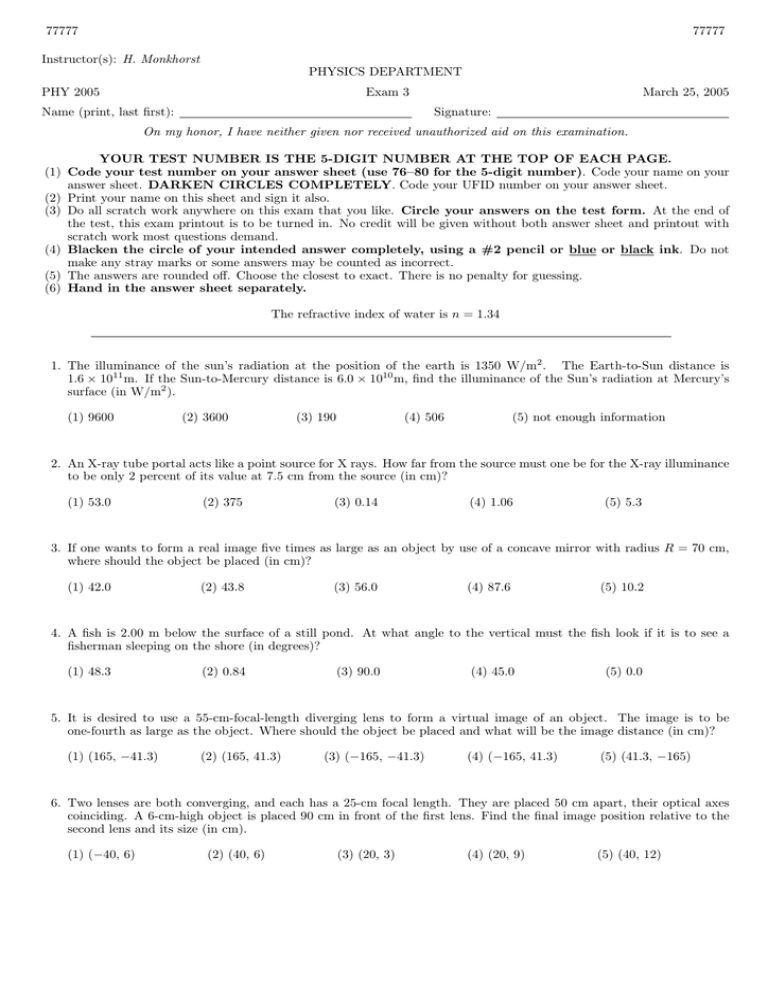
77777 77777 Instructor(s): H. Monkhorst PHYSICS DEPARTMENT PHY 2005 Exam 3 Name (print, last first): March 25, 2005 Signature: On my honor, I have neither given nor received unauthorized aid on this examination. YOUR TEST NUMBER IS THE 5-DIGIT NUMBER AT THE TOP OF EACH PAGE. (1) Code your test number on your answer sheet (use 76–80 for the 5-digit number). Code your name on your answer sheet. DARKEN CIRCLES COMPLETELY. Code your UFID number on your answer sheet. (2) Print your name on this sheet and sign it also. (3) Do all scratch work anywhere on this exam that you like. Circle your answers on the test form. At the end of the test, this exam printout is to be turned in. No credit will be given without both answer sheet and printout with scratch work most questions demand. (4) Blacken the circle of your intended answer completely, using a #2 pencil or blue or black ink. Do not make any stray marks or some answers may be counted as incorrect. (5) The answers are rounded off. Choose the closest to exact. There is no penalty for guessing. (6) Hand in the answer sheet separately. The refractive index of water is n = 1.34 1. The illuminance of the sun’s radiation at the position of the earth is 1350 W/m2 . The Earth-to-Sun distance is 1.6 × 1011 m. If the Sun-to-Mercury distance is 6.0 × 1010 m, find the illuminance of the Sun’s radiation at Mercury’s surface (in W/m2 ). (1) 9600 (2) 3600 (3) 190 (4) 506 (5) not enough information 2. An X-ray tube portal acts like a point source for X rays. How far from the source must one be for the X-ray illuminance to be only 2 percent of its value at 7.5 cm from the source (in cm)? (1) 53.0 (2) 375 (3) 0.14 (4) 1.06 (5) 5.3 3. If one wants to form a real image five times as large as an object by use of a concave mirror with radius R = 70 cm, where should the object be placed (in cm)? (1) 42.0 (2) 43.8 (3) 56.0 (4) 87.6 (5) 10.2 4. A fish is 2.00 m below the surface of a still pond. At what angle to the vertical must the fish look if it is to see a fisherman sleeping on the shore (in degrees)? (1) 48.3 (2) 0.84 (3) 90.0 (4) 45.0 (5) 0.0 5. It is desired to use a 55-cm-focal-length diverging lens to form a virtual image of an object. The image is to be one-fourth as large as the object. Where should the object be placed and what will be the image distance (in cm)? (1) (165, −41.3) (2) (165, 41.3) (3) (−165, −41.3) (4) (−165, 41.3) (5) (41.3, −165) 6. Two lenses are both converging, and each has a 25-cm focal length. They are placed 50 cm apart, their optical axes coinciding. A 6-cm-high object is placed 90 cm in front of the first lens. Find the final image position relative to the second lens and its size (in cm). (1) (−40, 6) (2) (40, 6) (3) (20, 3) (4) (20, 9) (5) (40, 12) 77777 77777 7. Using a diffraction grating with 9000 lines/cm, the third-order maximum is found at an angle of 80◦ on each side of the straight-through beam. What is the wave length of the light (in nm)? (1) 365 (2) 547.5 (3) 1094 (4) 183 (5) 730 8. Suppose diffraction limits the ability of a person’s eye to see detail. Suppose further that the pupil of the eye has 0.23 cm diameter. How far from the eye can a millimeter scale be held and still have the millimeter lines clearly resolved with light λ = 580 nm (in cm)? (1) 325 (2) 397 (3) 484 (4) 3.25 (5) 3.97 77777 77777
